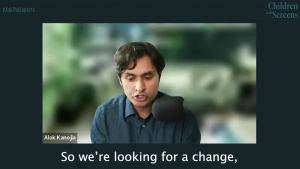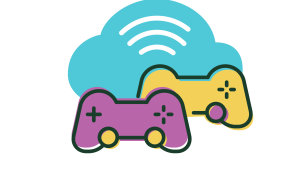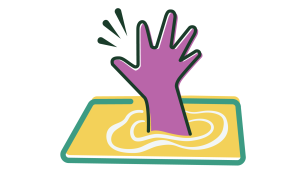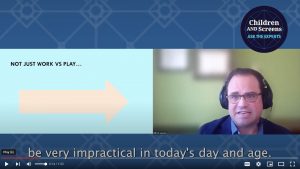
High levels of digital media use by children and adolescents are of concern to parents and caregivers for good reason: a third of teens report 1 “almost constant” daily use of social media platforms alone, and nearly half of adolescents ages 11-12 who own mobile phones report losing track of how much they are using these devices.2
Many online platforms are expertly designed to encourage addictive use but when does heavy use become problematic and when does it become a digital addiction? What are the warning signs, and how can families head off addictive use and address the problem if their child’s use crosses this threshold?
Children and Screens convened a panel of clinical specialists in child and adolescent digital addiction, researchers, and parents of youth with lived experience of gaming addiction to provide a guide to assist families in preventing, recognizing, and coping with youth digital addiction.
Defining Digital Addiction
What is digital addiction?
“When we talk about problematic use of the internet, what do we really mean? It’s an umbrella term – it covers a lot of different behaviors that have become problematic in relation to or relative to screens. [Digital addiction] ranges from gaming, pornography, viewing, gambling, shopping and buying, video streaming, social media, and cyberchondria, which is online searching for medical information,” says Naomi Fineberg, MBBS, MA, MRCPsych, Professor of Psychiatry, University of Hertfordshire.
The brain chemistry of digital addiction
Clifford Sussman, MD, Child, Adolescent, and Adult Psychiatrist and Internet and Gaming Addiction Specialist, provides insight into the chemistry of brain reward systems that lie behind digital addiction. “Dopamine is the reward neurotransmitter, a chemical that’s released when we get what we want, when we want it – dopamine release is much more based on the speed at which we get what we want, rather than what we’re actually getting,” he says.
Because digital media use by nature gives us what we want, quickly and continuously, dopamine release naturally occurs, and we need the “brakes” of the prefrontal cortex to help us get off at appropriate times, says Dr. Sussman. “Unfortunately, in our teenagers and in our kids, their brakes are not as developed as when they get older. When you have underdeveloped brakes and you’re on your screen, what can happen is that you just keep going and you don’t get off – that’s when you start to have problems, because when you finally do get out, you’re still craving it” he says. Children may respond to these intense cravings with irritability, defiance/aggression, and going to extreme lengths to get back on their screens.
Similarities to other disorders
“Some of these disorders might look like other disorders, maybe more than addictions,” says Fineberg. “Online shopping or pornography viewing may be closer to impulse control disorders, where you get this irresistible urge to do it, even though you know it’s going to be harmful later.”
Other compulsive behaviors like checking emails, digital hoarding, cyberchondria, or “fitspiration” (being obsessed with fitness and exercise) are closer to OCD, says Fineberg, where the behavior is done repetitively to avoid feeling bad or avoid bad consequences. Excessive social media use can be more like social anxiety disorder – avoiding in-person social experiences in favor or online interactions – or FOMO, with a pervasive fear of missing out or not being up-to-date.
Limits of official recognition and diagnosis
Official definitions for clinical diagnoses of digital addictions are still evolving. “There’s still a critical scarcity of reliable scientific evidence or information on many key issues related to this,” says Fineberg.
As of late 2023, the International Classification of Diseases (ICD-11) recognizes only two specific disorders related to addictive behavior – gambling disorder and gaming disorder, each of which can have the Internet as a diagnostic specifier. There is also a category of nonspecific addictive disorders that aren’t either gambling or gaming but share similar characteristics.
Signs of digital addiction
How can parents and caregivers distinguish if their child’s heavy use of online platforms or content has become problematic or addictive?
Inability to stop
“First is impaired control – you try to stop doing it and you can’t. There are strong cravings and motivational preoccupations to do it,” says Fineberg. “It’s not the amount of time you’re gaming, it’s whether you can control it or not that’s key… not being able to control starting and stopping the frequency and duration of the gaming.”
Neglect of other important life areas
“With addiction, you want to look for the problems caused by the use, not just the use itself. So are there social problems? Are there academic problems? Are there health and are there psychological problems?” says Dr. Sussman.
“As a result of prioritizing that use or behavior, you neglect important other areas of your life, like sleep or your education or your work or your relationships – and you continue to engage, even though you know it’s risky and even though you know it’s damaging,” says Fineberg.
Symptoms of withdrawal
Similar to addictions such as substance abuse and gambling, withdrawal symptoms like moodiness, disrupted sleep, and extreme agitation may occur when the child is unable to engage in their digital use, says Fineberg, though it’s not clear from current research whether these symptoms occur with all Internet use disorders or just some.
Changes in typical behaviors, affects and hygiene
Elaine Uskoski, video gaming addiction speaker, author, and Family Coach, shares her experience as a mother of a gaming-addicted child.
“In grade 12, I started noticing [my son] was fatigued a lot and his grades started to slip. When he went off to university for the first year, he wasn’t communicating a lot and was sleeping during the day. In the summer between first and second year, he was gaming an enormous amount – I approached him about it and he became very angry with me. When he went into second year, I didn’t hear from him hardly at all, and when I did see him, he looked like he’d been losing some weight, and he did have a body odor – but he seemed to always have an answer for everything.”
(For more of Elaine’s family story, see her first person account, “One Mother’s Story,” below.)
Prevention tips
Encourage alternative activities
“So many kids that I work with say ‘I don’t have anything else. I’ve never done anything other than play video games’,” says Uskoski. In those cases, it’s difficult to find ways to fill the gaps when trying to intervene with a gaming or screen addiction. Finding and nurturing enjoyable off-screen activities earlier in childhood gives older children an alternative outlet when one is needed.
Uskoski also suggests scheduling these specific alternative activities for right after gaming time, which helps avoid longer gaming or Internet binges without a cutoff time cue.
Set reasonable limits and rules with a family media use plan
Every family has its own unique considerations for screen time and media use, which makes it near-impossible to recommend a “one-size-fits-all” set of media rules, but all families can benefit from a family media use plan, says Jason Nagata, MD, MSc, Associate Professor of Pediatrics at the University of California, San Francisco. Family media plans address key aspects of media use such as acceptable times to engage in gaming and other online activities, establishing screen-free times and zones in the house (such as bedrooms, bathrooms, mealtimes), plans for digital privacy and safety, and family rules for balancing screen time with other activities like physical activity.
After setting up the family media plan, be careful not to treat it as an ironclad contract that means parents or children have “failed” if not strictly followed, cautions Dr. Sussman. “Rules are going to be broken. That’s something you have to understand as a parent. You can set up rewards for following the rules, and you can set up reasonable, logical consequences for breaking them. You might say ‘these are the house rules that we follow. And this is what happens if you follow them and this is what happens if you break them’,” he says.
Recent research also supports specific parental interventions as helpful strategies for avoiding problematic use in early adolescents. “Parental monitoring and restriction of screen use are associated with lower problematic social media and mobile phone use” in studies based on the ABCD (Adolescent Brain Cognitive Development) Study, says Dr. Nagata.
Be unafraid of “bored” time for kids
Some parents may feel that screen time is preferable to children being bored. Uskoski cautions against this. “Allow your children to be bored – that opens up the imagination for creativity. We’ve become so used to being entertained by our digital devices that we don’t like to sit and ruminate in our heads and be alone. It’s important that children learn that boredom is not a terrible thing, that you can really be creative in your boredom,” she says.
Role model responsible use
Demonstrating responsible media use as a parent or caregiver is very important, says Uskoski. “Our children are watching us and they’re paying very close attention” to how parents use their digital media, she says.
Recent studies indicate that for young adolescents, “greater parental screen use, and parents allowing mealtime screen use or bedtime screen use, is associated with greater problematic screen use,” says Dr. Nagata.
Keep the reins on credit cards
Most online games now encourage spending of real money via “loot boxes” and other enticements designed to maximize extra in-game expenditures, which can quickly get out of hand. Uskoski recommends keeping parent credit cards to adult use only, and if in-game spending is allowed, to give children gift cards with limits to keep spending under control and teach them budgeting skills.
What to do if you suspect your child has a digital addiction
Help youth take ownership of the problem
Dr. Sussman strongly urges parents to avoid the “head-on attack” approach when dealing with a child with digital addiction. “They may just run the other way,” he says. “It’s much better if you can get them to tell you what problems they’re having than you telling them what problems they’re having and what they need to do, because they’re often going to do the opposite of what they feel an authority figure is telling them to do.” In his clinical practice, Dr. Sussman uses the “motivational interviewing” approach which encourages children to become their own authority figure and puts the adult more in a listening and reflective role that can more helpfully add insight.
Listen without judgment
Parental feelings of shame or failure may lead to reactions to a digital addiction that feel judgmental to a child. Uskoski urges parents to focus on being open-minded and “really listen to our children and understand what they’re going through in their lives,” as addiction is often a symptom of other things going on with the child that need to be unearthed and addressed, she says.
When talking about the problem, focus on your own feelings and emotions instead of what the child should do, says Uskoski. “I often tell parents to plant seeds and talk to your kids about what you miss, what you are missing now that they’re locked in their rooms. You don’t necessarily have to say ‘If you weren’t gaming we could be spending more time together.’ You can say ‘I miss our times together and I miss seeing you light up when we go out together’,” she says.
Avoid only communicating about the problem
To keep lines of communication open, focus on building the parent-child alliance and try to refrain from making all conversations about the addiction problem, says Uskoski. If every time the child comes to the family table the conversation tries to address their gaming or other problem, the child may choose to eat near their screen instead. “Stop talking about the problem and start having light, interesting conversations. Get to learn what they’re struggling with and who they are,” she says.
Reduce harm rather than go “cold turkey”
“I generally start with harm reduction” when working with children and families coping with a digital addiction, says Uskoski. This involves reducing rather than eliminating the time spent online and attempting to introduce other activities into the child’s life, as well as talking about why they may be using it as a form of escapism from something else. In some cases, “detox is required to heal the brain for a little time and then we can reintroduce gaming at a moderated amount afterwards,” she says.
Dr. Sussman also recommends against a “cold turkey” approach and instead suggests retraining the child brain to acclimate to both “high-dopamine” activities and “low-dopamine” activities. “By high dopamine activity, what I’m talking about is activities that are instantly and continuously stimulating, like playing a video game or being on TikTok, whereas a low-dopamine activity is an activity that requires more patience, where we have to put more effort in to get what we want, where there’s more delay in our gratification such as doing homework or doing exercise or maybe playing a musical instrument,” he says, as the goal of treatment is helping patients find a balance between the two.
Dr. Sussman is careful to note that some screen activities can still be “low-dopamine” activities. “The reason I don’t just separate it into screen activities and non-screen activities is because you can actually do a load of other activities on a screen – coding, for example, or making PowerPoints could be a low dopamine activity that you do on a screen,” says Sussman. However, it’s usually more effective to find non-screen low-dopamine activities as the temptation to switch to the other problematic behaviors while on an Internet-connected screen may be too great.
Limit temptations and cues in the home
“Cues are a big factor,” says Dr. Sussman “The brain starts to release dopamine even before it gets what it wants from the cues because it’s about to receive what it wants. When someone with alcohol use disorder walks into a bar, they get all the sight, smells and sounds of the bar, and that’s what causes their brains to release dopamine before they even had their first drink. A lot of the work I do with kids and families is about adjusting the cues in the house and trying to separate high-dopamine cues from low-dopamine cues,” says Dr. Sussman. Heavy family device use and a proliferation of devices and screens in the home can act as these cues for digitally-addicted children.
Take a hard look at your own device use as well. “If you’re on your mobile phone at the table or when you’re talking to your child, you can’t be surprised if they’re going to prioritize that behavior as well,” says Fineberg.
Work toward establishing healthy routine and schedule
Dr. Sussman emphasizes to families the importance of having a structured day, preferably with a schedule and consistent routines. When low-dopamine activities are scheduled into the day, such as sports or band practice, there is a natural reduction in the amount of unstructured time that will require more effort to keep balanced.
De-escalate power struggles
Children dealing with a digital addiction may engage in power struggles or become aggressive when caregivers try to intervene or interrupt screen time. Dr. Sussman advises parents and caregivers that these situations “come with the territory” in dealing with digital addictions, and advises to plan and get strategies in place beforehand. “A general rule of thumb for de-escalating is to just try to see if you can avoid all physical types of interventions – sometimes you just have to get away until the risk of aggression has subsided,” he says. In some cases these strategies may need to include consulting professionals for medication or psychotherapy approaches to minimize aggression, depending on the individual.
Fineberg advises a contextual approach when limits are exceeded, taking into account the situation before requiring immediate compliance. “If they’re playing a game where it’s important that they finish a certain game and they’re on it with all their friends across the world, if you make them stop in the middle of the game, that’s just never never going to work,” she says, “Negotiate that with your child and let them get to the end of the game before stopping and in other similar situations.”
Build new community
For digital addictions like gaming addiction, the child may be isolating from family and in-person relationships, but likely has an online social community entirely based around their online behavior. Building a new community outside of the online world was “the most important step” for her gaming-addicted son, says Uskoski. “He realized that he could leave his room, he could spend time with people, and it could be just as meaningful as it was online.” Online friendships are real friendships, but developing social relationships outside of a space that provides constant cues for engaging in problematic behavior can be a helpful step towards more balanced use.
Find balance in your parenting approach
Parents may zigzag between extremes on both sides of the parenting spectrum when dealing with a digital addiction, says Dr. Sussman, approaching the problem either with extreme limit-setting that leads to micromanaging, or “giving up” and providing zero oversight, which can lead to enabling and discourage the development of the self-regulation skills kids need for healthy adult functioning.
“I’m trying to help parents balance their approach to how to deal with this problem, because I find that parents have trouble finding a balance between knowing what limits to set and what sort of natural consequences to put in place to encourage their kids to self-regulate and be more independent and set their own limits,” says Dr. Sussman. “As their kids go from younger to older teenagers, I’m trying to help parents start out with more limit-setting and go gradually towards more self-regulation” to set up older children with the skills they need to self-manage once they leave the home.
Fineberg agrees that balance within the entire family is key to finding a path forward. “It’s about this great emphasis on balance and making sure that your lifestyle is well balanced with your children, that there’s plenty of social interaction and exercise and all those other things going on, as well as allowing screen time, but within reasonable limits,” she says.
Get professional help when needed
It’s okay if the problem is bigger than you can handle by yourself as a parent. Professional therapists and clinicians may be able to address the problem more effectively, says Uskoski. These professionals can also help identify other possible problems or core issues that may be contributing to the digital addiction.
If confused about where to go or who to see, Dr. Nagata suggests a pediatrician or primary care doctor as a first step, as they should be able to make appropriate referrals based on the child’s needs.
Dr. Sussman recommends assessing how dysfunctional the behaviors have become or how large the associated problems it’s causing have grown. “It’s difficult because you have to make sure that even kids who don’t say they have a problem or are in denial still get the help they need. Sometimes it’s better to err on the side of seeking help.”
It’s very common for children and anyone with a compulsive use problem to be ambivalent and resist getting help, says Dr. Sussman, “but if you’re having these types of problems, I think it really is important to call a professional psychologist or psychiatrist to try to schedule an intake appointment. You often can’t do it with the information you have by yourself,” he says.
Considerations for neurodiverse youth with a digital addiction
Adjusting the family’s approach to digital addiction should always take into account the particular needs of the individual child, including neurodivergent children, says Dr. Sussman. Youth with Autism Spectrum Disorder in particular often need more predictability in routine and schedule in order to avoid power struggles. “A great way to prevent power struggles and aggression and all sorts of issues [with neurodivergent children] is to let them know ahead of time not only what their schedule is, but exactly how much time they are going to get on the screen, and to let them know exactly what the consequences would be if they don’t get off when it’s time,” says Dr. Sussman. “Sometimes even a five minute warning prior to ending can prevent aggression or a power struggle.”
________
1 “Teens, Social Media and Technology 2023”, Pew Research Center (https://www.pewresearch.org/internet/2023/12/11/teens-social-media-and-technology-2023/)
2Nagata, J. M., Singh, G., Sajjad, O. M., Ganson, K. T., Testa, A., Jackson, D. B., … & Baker, F. C. (2022). Social epidemiology of early adolescent problematic screen use in the United States. Pediatric research, 92(5), 1443-1449.
————
- Marc Potenza, MD, PhD, Professor of Psychiatry, Yale University School of Medicine
- Elaine Uskoski, Video gaming addiction speaker, author, and coach; Family Coach, Game Quitters
- Naomi Fineberg, MBBS, MA, MRCPsych, Professor of Psychiatry, University of Hertfordshire
- Jason Nagata, MD, MSc, Associate Professor of Pediatrics, University of California, San Francisco
- Clifford Sussman, MD, Child, Adolescent, and Adult Psychiatrist; Internet and Gaming Addiction Specialist
[Elaine Uskoski, Video gaming addiction speaker, author, and coach; Family Coach]: My story began on October 31st, 2014, when I received an S.O.S. email from my then 19 year old son, Jake, who was attending university an hour away from where we lived.
Although I say that this letter came as a shock, it also didn’t because I’d had this “spidey sense” that something wasn’t right with my son, I just couldn’t put a finger on what it was. And he was in trouble, and he was very fragile-sounding in the letter. I know it was difficult for him to confess, but he had not been attending classes for two months. He instead had been holed up in his residence room. He’d been gaming up to 16 hours a night until he would literally pass out. He would sleep all day and then at night he would wake and start that process again.
The university caught up with him and they had said that the locks were being changed in his dorm and that he had three days to move out. So he reached out to me and my first reaction was “Thank goodness he trusted me enough to reach out,” because I know he could have made a different decision. So I picked up the phone and I said, “What do you need?” Of course, he burst into tears and said, “I want you to make this okay. Tell me this will be okay.” I said I would.
I didn’t know what that was going to look like. I got in my car and I drove to the university and it was the longest hour of my life. He sounded so fragile in the email and he sounded so fragile on the phone that I thought he might take his life in shame before I got there. When I arrived, he opened the door and I opened my eyes. There stood my six-foot-two son, and he had dropped to 127 pounds. He had facial tics. He had tremors. His eyes were dilated. His skin, which was normally squeaky clean, was a mess of acne. His hair was greasy. He’d been wearing the same clothes for days and days, and he smelled horrific. And he looked terrible. My heart broke. I just hugged him and hugged him and hugged him. We both cried so much.
And then I brought him home. Many unanswered questions began to unravel as we drove. And I started realizing that his excessive video gaming was a problem. I’d seen signs before he left for university and I ignored them. But it was now clear to me that he had a problem with video games. And so I told him that I was going to detox him from gaming while we sorted out school. I took him to the doctor to make sure he was healthy. He was diagnosed with very low vitamin D levels, I guess because he’d been in the dark for so long, and severe anxiety and depression. He did not want to do medication, but he agreed to see a counselor.
We began the detox process, and it was incredibly painful for him. He had headaches. It was difficult to get back on a regular sleep cycle. It was like going through jet lag. So the next couple of weeks, he mourned the loss of his online friends because he wasn’t making friends at university. He felt agitated. He felt more depressed. I got him to exercise. I got him eating right, hoping that that would help elevate his mood. And he started counseling.
During that time, we learned also that during the first year, he’d failed three courses. Rather than having him be two years behind in school, we decided that after his eight weeks of counseling, he would go back for the second semester and he would pick up those three courses that he failed. And so we did.
I got that awful “spidey sense” once again after I released him to his residence, and I only heard once from him that week, it was 3:00 in the afternoon on Monday, and he said, “Survived day one.” And then I didn’t hear from him again. So that weekend my husband and I drove back to the university to check on him and when he opened the door, I realized immediately he’d relapsed again. It took some time for him to admit that, but I said, “If you want help, you need to be transparent with us, otherwise we can’t help you.”
So he was brought home once again, and we had a long discussion. I asked him if he still wanted to be in university. Of course he said he did, but he still didn’t think he had a gaming addiction. He thought he had a time management issue, and he thought gaming was just getting in the way of him getting his degree. So once again, I asked him what he needed, sky’s the limit. “I will put my business on hold. I will do whatever you need.” And he thought about it and he said, “I need you to drive me to school and walk me to class until I can do it on my own. If you leave me alone, I think I will still game.” So that’s what I did. I did that for several weeks until he felt he could be on his own at school. And then he was required to send me photographs of himself in the lecture hall and in the classrooms to prove that he was actually attending. He had to come home every weekend to be monitored. It was a long, hard process. It was a painful process. He relapsed many, many times.
I went to the university and got him some help. I did ask for him to see a counselor and he had a peer support person and he had a special needs advisor at the school. So he had extra support there. I wasn’t handling this totally on my own. He never did get addiction counseling. There wasn’t a lot available in 2014 for video gaming addiction, and so he made use of the counseling at school. He worked through self-esteem issues and how to better manage his school program. And how to manage his life in a healthier way.
After two and a half years of relapse and detox, he finally came to the conclusion that video gaming was going to destroy his life, that he would have no opportunity to get a job once he got his degree, so he made a commitment to stop gaming. That was six years ago this summer. And he did, with a lot of help, get his degree in his fifth year of university. During his last school year, my husband and I sold our home and moved to the city that his university was in so he could live with us and have a typical university year where he could join things on the weekends, attend parties, make friends and create a new community rather than the online community that he had found solace in for all of those years.
Today, he is living on his own in Toronto. He is a software engineer. He’s very successful with his work. He has found so many wonderful other activities to do to fill his life. He has lots of friends. He’s still very close to his family and I’m really proud of him. When he can, he sometimes speaks with me, and any time that he can help another person overcome their addiction, he’s really pleased.






